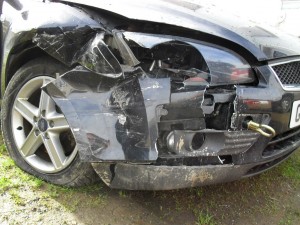
The general rule is that, if you are driving a vehicle and run into the back of someone else, it will be your fault and you will not be able to make a claim against anyone else.
This law seems to be generally well understood.
What if the driver in front behaved unreasonably?
From time to time, we get enquiries from people who have rear-ended another vehicle but consider that the accident was not their fault because the driver in front stopped their vehicle suddenly or without good reason.
An example of this is where you are second in the queue at a T-junction and you and the car in front are both turning left.
You can see there is plenty time for you to turn onto the main road as well as for the car in front of you. Your attention is maybe more to the right than in front of you as you have no reason to expect the car in front not to ‘go and keep going’. However, for some reason, the car stops.
Maybe the driver stalled or decided it wasn’t safe to proceed.
In that situation, you’re going to have difficulty avoiding full blame for the collision – which could include damage to the other vehicle and injury to its occupants, as well as injuries to the passengers in your vehicle.
What the Highway Code says
The Highway Code (para. 126), in relation to Stopping Distances, recommends that “you should drive at a speed that will allow you to stop well within the distance you can see to be clear.
You should leave enough space between you and the vehicle in front so that you can pull up safely if it suddenly slows down or stops.
Allow at least a two-second gap between you and the vehicle in front on roads carrying faster-moving traffic and in tunnels where visibility is reduced.
The gap should be at least doubled on wet roads and increased still further on icy roads.”
It also points out that large vehicles and motorcycles need a greater distance to stop.
How Difficult it is to Blame the Driver in Front …
An English case decided in the Court of Appeal in 2011 illustrates how rare it is for courts to blame the driver of the car in front where it has been hit from behind.
There was not actually a collision between the vehicles here but the principles are the same.
On 31 July 2008, 69-year-old Valerie Steadman was a passenger on a London United Busways (LUB) 49 bus on Kensington High Street in London.
The bus was immediately behind a Ferrari sports car, driven by a Mr Sala.
Suddenly, the bus driver braked hard, causing Mrs Steadman to be thrown from her seat and suffer a serious spinal injury, resulting in tetraplegia.
The bus driver claimed that the Ferrari had braked without warning, requiring him to do an emergency stop to avoid a collision.
Mr Sala was not aware of any accident at the time and was only traced by the police sometime later. He denied that he had braked suddenly or done anything to cause the accident.
Mrs Steadman’s claim was against LUB but they tried to pass the blame onto Mr Sala.
The court had to decide whether the accident was the fault of the Ferrari or of the bus driver or a combination of the two.
The evidence included the two drivers, various other eye witnesses, experts and footage from CCTV cameras.
Bus driver entirely to blame
The court’s conclusion was that the accident was solely the fault of the bus driver.
Due to his impatience (which had led him to sound his horn on two occasions before the incident happened), the bus had been driven too close to the car in front, meaning that the bus driver did not have enough time to react to what was happening in front of him.
The judge said that Mr Sala’s main focus reasonably had to be on what was happening in front of him rather than behind him.
It was inconceivable that Mr Sala would have braked deliberately; he would not have put himself or his expensive vehicle at serious risk of being struck by a bus and, as a doctor, he would not have exposed the bus driver and passengers to risk of injury.
Can a Car Accident Ever be the Fault of the Car in Front?
The answer is “yes”, though the accident is unlikely ever to be wholly the fault of the vehicle in front.
A recent Scottish example is to be found in the case of Bellingham –v- Todd.
In that case, various relatives of a 40-year-old motorcyclist who died as the result of a collision on the A71 in Ayrshire claimed against the driver of a van which had been in front of the motorcyclist immediately before the accident.
The van driver had braked sharply when the pick-up truck in front of him had stopped to turn right at a junction.
The motorcyclist had had to swerve to avoid the van but had clipped it and lost control, ending up in the path of oncoming traffic.
The court took the view that the motorcyclist had been too close to the van but that the van driver had failed to pay proper attention to the traffic in front of him and carried out emergency braking for no good reason.
This meant that the family’s claim was successful.
However, the motorcyclist was still held to be 80% to blame and so the recovery was of only 20% of the assessed damages.
Get in touch with us for help
If you have any road accident related questions, please do not hesitate to contact Peter Brash by email or via 01343 544077.
If we cannot help you directly, we will probably know someone who can help you.
All initial enquiries are free of charge and without obligation.